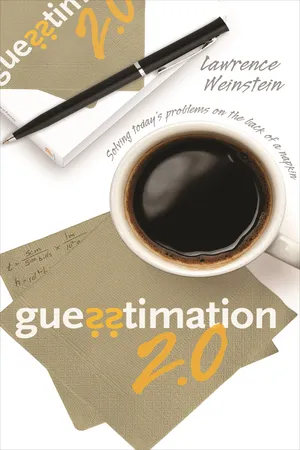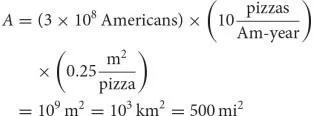![]()
How to Solve Problems
Chapter 1
¿ ¿ ¿ ¿ ¿ ¿ ¿ ¿ ¿ ¿ ¿ ¿ ¿ ¿ ¿ ¿ ¿ ¿ ¿ ¿ ¿
Why estimate?
Because we need to know an answer so we can decide what to do. If we’re deciding whether to drive to Virginia Beach for the weekend, we need to estimate how long it will take. If we’re deciding whether to get a solar panel on our new car, we need to estimate how much gas it will save. If we’re deciding between paper and plastic, we need to estimate how much plastic is in the bags we use each year. All these questions (and many more) lead to actions. If the drive is too long, we won’t go to Virginia Beach. If the solar panel generates enough energy, we’ll buy that option. If we only use a few pounds of plastic bags in a year, we won’t agonize over the choice.
We are not looking to determine the answers to these questions precisely. We just need to determine them well enough to decide on an action. This means answers fall into one of the three “Goldilocks” categories:
- too big
- too small
- just right
If the answer is too big or too small, then the action is obvious. If the driving time is about 1 hour (too small) then we will drive to Virginia Beach for the weekend. If the driving time is about 10 hours (too big) then we won’t. Only if the driving time is in between (just right), do we need more information (such as how much traffic to expect). Similarly, if the solar panel option on the new car will save about 500 gallons of gasoline each year (too big), then we will buy the solar panel. If the solar panel option will only save about 5 gallons of gasoline each year (too small), then we will not buy it. If it will save an intermediate amount, then we need to do more work to get a more precise answer. Similarly, if we use 1 pound (too small) or 1,000 pounds (too big) of plastic bags a year, then our “paper or plastic” decision is easy. Only if the answer is intermediate (just right) do we need to do more work to determine the exact relative environmental impact of plastic and paper bags. However, the extra work to achieve that level of precision is way beyond the scope of this book.
In this book, we will only try to estimate answers to within a factor of ten, as that will be good enough for most questions.
How do we estimate? There are three steps and one technique to make it easier. First, write down the answer. Second, if necessary, break the problem down into small pieces. Third, recombine the pieces. The final step is to compare our answer to the Goldilocks categories. The technique is to establish boundaries for the answer rather than to estimate it directly.
Let’s look at this in more detail.
Step 1: Write down the answer to within a factor of ten.* Many problems are simple enough so that we can answer them immediately (within a factor of ten). How long does it take a pumpkin to fall from a ten-story building? How much does a new compact car cost? How long does it take to fly across country? All of these can be answered immediately (10 seconds, $20,000, and 6 hours). However, you need to remember one principle.
Dare to be imprecise!
None of those answers is precisely correct. Precise answers take a lot more time. However, most questions do not need persnickety precision. If you want to buy a car and can only afford to spend $5,000, then you cannot buy a new car. If you can afford to spend $100,000, then you can buy a new car. Only if you have an intermediate amount, for example $15,000, do you need to know the cost of a new car more precisely.
Of course, if all problems were this easy, you would not bother with this book. If the problem is more complicated than that, we need to simplity it.
Break down the problem
Step 2: Break the problem into smaller pieces. Write down the answer to each of these pieces to within a factor of ten. If the smaller pieces are still too complicated, break them down further. Then we
Recombine the pieces
Step 3: Take the estimates of each piece and multiply them together to get the overall estimate. For example, if we want to estimate the total time that all college students talk on their cell phones, we would multiply our estimate of the number of college students by our estimate of the time each student spends on the phone.
Estimate by bounding
Technique: It is often easier and more reliable to estimate upper and lower limits for something than to estimate the quantity directly. Consider estimating the amount of time each day that the average college student spends talking or texting on his or her cell phone. We don’t know if it is 10, 27, 34 or 62 minutes. However, we can confidently claim that it is more than 2 minutes and less than 3 hours (or 200 minutes).*
Now we just need to convert those bounds to an estimate. The way to do it is to take an average. But we won’t just add the upper and lower bounds and divide by two. That would give us an estimate (100 minutes) that is a factor of two lower than our upper limit, but a factor of fifty greater than our lower limit. Because our goal is to estimate an answer within a factor of ten, we could be way off. (Especially after multiplying the estimates of each piece together.)
The solution is to take the geometric mean. The geometric mean of two numbers is the square root of their product. For example, the geometric mean of 5 and 20 is 10, because 10 =
However, we won’t calculate square roots on the back of a cocktail napkin. That would be too ostentatious and needlessly precise.
To take the
approximate geometric mean of any two numbers, just average their coefficients and average their exponents.
† In the phone case, the geometric mean of 2 (2 × 10
0) minutes
‡ and 200 (2 × 10
2) minutes is 20 (2 × 10
1) minutes, because 1 is the average of the exponents 0 and 2. Similarly, the geometric mean of 2 × 10
15 and 6 × 10
3 is about 4 × 10
9 (because 4 =
and 9 =
).
If the sum of the exponents is an odd number, the procedure becomes a little more complicated. Then you should round the resulting exponent down, and multiply the final answer by three. Therefore, the geometric mean of 1 and 103 is 3 × 101= 30.
Compare the answer
After we estimate the answer to a question, there is always one final step. Presumably, we attacked that particular question because the answer might mean something or might guide our actions. However, answers only mean something when compared to something else. Therefore, we need to compare the answer to a reasonable (or unreasonable) standard. Only then can we determine which of the three Goldilocks categories the answer falls into.
Failures of estimation
Lastly, we need to think about when estimation fails. There are three types of failure. First, we may badly over- or underestimate a quantity. However, if we bound our estimates carefully, we should be able to recognize possible problems. For example, if our lower and upper bounds are 102 and 103, then we can be pretty confident that our estimate of 3 × 102 is reasonably good. If our lower and upper bounds are instead 1 and 105, then our estimate is the same, but it has a much larger margin of error.
Second, we may choose the wrong model for our estimate. If we try to estimate the number of automobile accidents per year in the United States, we would get different answers if we assumed that they were mostly caused by teenagers, by senior citizens, by distracted parents, or by drunk drivers.
Finally, we may choose a nonlinear problem. Typically, we assume that if we do something and get a certain response, then two of us doing it will get twice the response (and 3 × 108 Americans will get 3 × 108 more response). This can fail spectacularly.
For example, if I stand on a diving board, it will bend a few inches. If you join me on the board, then it will bend about twice as much. But if twenty of us get on the diving board, it will not bend; it will break.
Similarly, if one car on the highway can transport one person 60 miles in an hour, then one hundred cars on the same highway can transport one hundred people 60 miles in that same hour. However, 104 cars on the same highway cannot transport 104 people 60 miles in an hour because they will cause a huge traffic jam.
These situations are rare, but we need to watch out for them.
Let’s get started.
Example 1: Paving with pizza boxes
How much area could we cover with all the pizza boxes used by Americans in one year? This is too complicated to estimate directly, so we need to break the problem into smaller pieces. Let’s estimate the number of pizza boxes we each use a year and the area of each pizza box.
How many pizzas does the average American order each year? We may not know the average, but we can set upper and lower bounds. It is more than one and less than one hundred. Thus, we will estimate that the average is the geometric mean, which is ten pizzas per year. Another approach would be to estimate the number of times per week or per month that we get pizza in a pizza box (either take-out or delivered). If we have pizza once a week and share a pie with a friend, that makes our share twenty-five pizzas per year.
Estimating the area is easier. A large pizza is 18 inches in diameter (or almost 0.5 m). The pizza box will be a slightly larger rectangle with an area of one-quarter square meter (0.25 m2). Now all we need to do is multiply.*
And now f...




